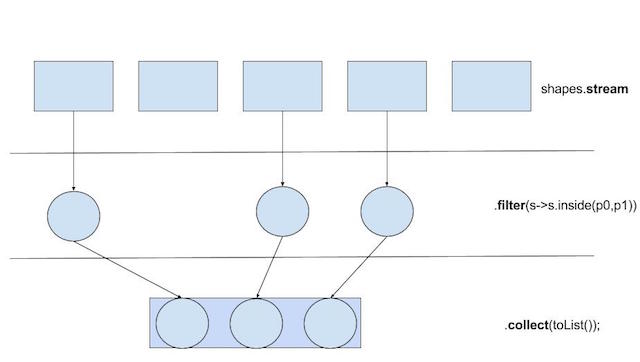Introduction
This tip is an introduction of declarative programming style in Java 8.
We will view the STREAM in Java 8, introducing some concepts of declarative/functional style to process the collections in other sources.
An example at a glance: shapes.
Given a collection of shapes represented by the "Shape Class", we want to collect all those that have an area less than 400, sorted.
Pre-Stream Solution
List < Shape > lowAreaShapes = new ArrayList < > ();
for (Shape s: shapeSet) {
if (s.getArea() < 400) lowAreaShapes.add(d);
}
Collections.sort(lowAreaShapes, new Comparator < Shape > () {
public int compare(Shape s1, Shape s2) {
return Double.compare(s1.getArea(), s2.getArea());
}
});
List < String > lowAreaShapesName = new ArrayList < > ();
for (Shape s: lowAreaShapes) {
lowAreaShapesName.add(d.getName());
}
Stream-Based Solution
import static java.util.Comparator.comparing;
import static java.util.stream.Collectors.toList;
List < String > lowAreaShapesName=
menu.stream()
.filter(s -> s.getArea() < 400)
.sorted(comparing((Shape s) -> s.getArea())
.map((Shape s) -> s.getName())
.collect(toList());

Points of Interest
What are the Benefits?
The evident impact is the elegance of our source code:
- More declarative
- We want to specify what we want, not how to get it
- Complex computations can be obtained by combining several operations together in cascade in pipeline style
- More composable
- We have algebraic composition, no side effect (how we note from the image upon)
- Parallelizable
- We can use, in the code, "
.parallelStream() ", instead ".stream()"
Example
For understanding the full power of streams, in general, we need a simple example.
We have the classes P2d and V2d which represent a point and a vector in a plane in the graphics viewport (that having extreme (0.0) as a corner the upper left and (w,h), w>0, h>0 as in the lower right corner), and the class BBox representing a rectangular bounding box. We want to define, in the same package, the class "Shape" that is characterized by the following methods:
package code.project.streams;
public interface Shape {
void move(V2d dv)
double getPerim()
bool isInside(BBox bbox)
bool contains(P2d p0)
}
Afterwards, define the classes that implement the interface upon:
LineRect (that represent a Rectangle)Circle
Class Line
A line must have two points: "a" (point extreme left) and "b" (point extreme right) - for example. Not only: all methods of interfaces "shape" must be implemented.
package code.project.streams;
public class Line implements Shape {
private P2d a, b;
public Line(int x0, int y0, int x1, int y1) {
a = new P2d(x0, y0);
b = new P2d(x1, y1);
}
@Override
public void move(V2d v) {
a = a.sum(v);
b = b.sum(v);
}
@Override
public double getPerim() {
return Math.abs(P2d.distance(a, b));
}
@Override
public boolean isInside(P2d p1, P2d p2) {
if ((Math.abs(a.getX()) <= Math.abs(p1.getX())) &&
(Math.abs(a.getY()) >= Math.abs(p1.getY())) &&
(Math.abs(b.getX()) <= Math.abs(p2.getX())) &&
(Math.abs(b.getY()) <= Math.abs(p2.getY())))
return true;
else
return false;
}
@Override
public boolean contains(P2d p) {
if (P2d.distance(a, p) + P2d.distance(b, p) == P2d.distance(a, b))
return true;
else
return false;
}
@Override
public String toString() {
return "Line - Point a(" + a.getX() +
"-" + a.getY() + ") Point b("
+ b.getX() + "-" + b.getY() + ")";
}
}
For the other class, you can download the complete source code.
Now, we want to define the "Utility" class with the following methods, using appropriate expressions and Lambda Stream in their implementation:
moveShapes
public static void moveShapes(List<shape> listShape, V2d v) {
listShape.forEach(s -> s.move(v));
}
inBBox
public static List<shape> inBBox(List<shape> listShape, P2d p0, P2d p1) {
return listShape.stream()
.filter(s -> s.isInside(p0, p1))
.collect(toList());
}
maxPerim
public static OptionalDouble maxPerim(List<shape> listShape) {
return listShape.stream()
.mapToDouble(s -> s.getPerim())
.max();
}
shapeWithMaxPerim
public static Shape shapeWithMaxPerim(List<shape> listShape) {
return listShape.stream()
.max((p1, p2) -> Double.compare(p1.getPerim(),
p2.getPerim()))
.get();
}
contains
public static Boolean contains(List<shape> listShape, P2d p) {
return listShape.stream()
.filter(s -> s.contains(p))
.findFirst()
.isPresent();
}
getContaining
public static List<shape> getContaining(List<shape> listShape, P2d p) {
return listShape.stream()
.filter(s -> s.contains(p))
.collect(toList());
}
logAll
public static void logAll(List<shape> listShape) {
listShape.forEach(System.out::println);
}
There are many examples to understand the power that the lambda expression has in general: without the streams, we would have had to write many lines of code; in this manner we can focus on "what" and not on "who".
For example, the method inBBox works in this manner:

Stages
- Creation of
stream from a data source
- with the instruction
listShape.streams()
- Application of one or more intermediate data processing operations
- there returns a
stream, so as to create pipelines - examples:
filter, map, limit, ...
- Closing operation
- used to collect/sink elements from the
stream, like a reducing. - examples:
collect: Converts the stream in another formforeach: Applies a lambda to every element of the stream???
Test the Streams
For testing the streams, we can call the static method in this manner:
package code.project.streams;
import java.util.Arrays;
import java.util.List;
public class TestShapes {
public static void main(String args[]) {
final List< shape > listShape = Arrays.asList(new Line(0, 0, 0, 7),
new Line (0,0,0,8),
new Rect(1, 1, 3, 5)
);
Utils.logAll(listShape);
Utils.moveShapes(listShape, new V2d(1, 1));
Utils.logAll(listShape);
}
}
Conclusion
As we can see, we can manage all shapes with the streams/lambda expression.
A few lines of code are enough for managing the shapes and making the code better, through a declarative style and therefore more readable. For the complete code, you can download here.
